Category: Sin categorizar
QUITO AIRPORT OPERATES WITHIN GOVERNMENTAL AND MUNICIPAL PROVISIONS
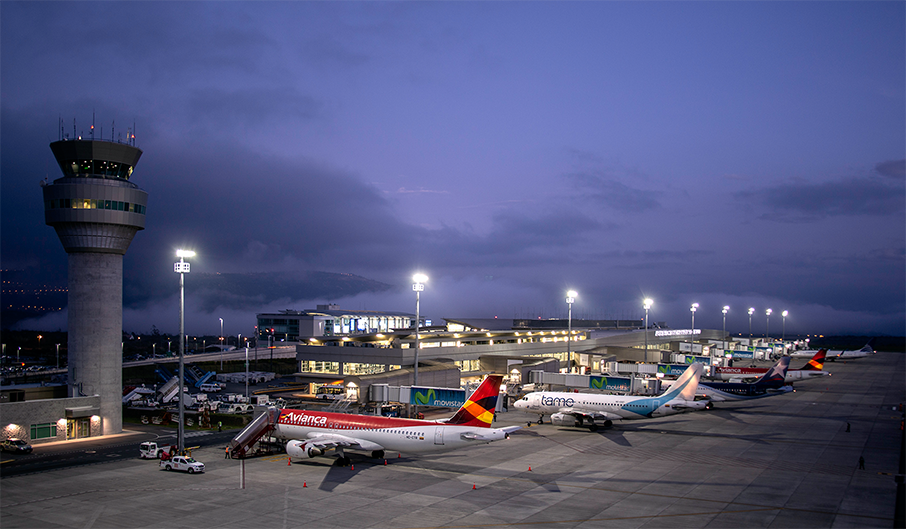
The Municipality of the Metropolitan District of Quito, using its powers to oversee the city’s airport service and in accordance with the decrees of the National Government, confirmed that international arrivals at the Mariscal Sucre International Airport of flights with passengers whose final or intermediate destination is the city of Quito will not be allowed.
The city authority also emphasizes that international cargo flights, aircraft that arrive without passengers to Quito to carry passengers abroad, as well as military and air ambulance flights, contemplated in Ministerial Agreement 003 of the Ministry of Transportation and Public Works, will be permitted to operate.
Corporación Quiport, the concessionaire in charge of the administration and operation of Quito’s airport, reiterates its predisposition to abide by all state, national and local guidelines, framed in the law and in the powers of each establishment.
According to the Municipality, these are policies that focus on favoring the wellbeing of the general population.
We ask citizens to follow health recommendations, avoid listening to and replicating rumors and false information, and to report through official channels.
QUITO INTERNATIONAL AIRPORT IMPLEMENTS A SUCCESSFUL ROUTE DEVELOPMENT STRATEGY
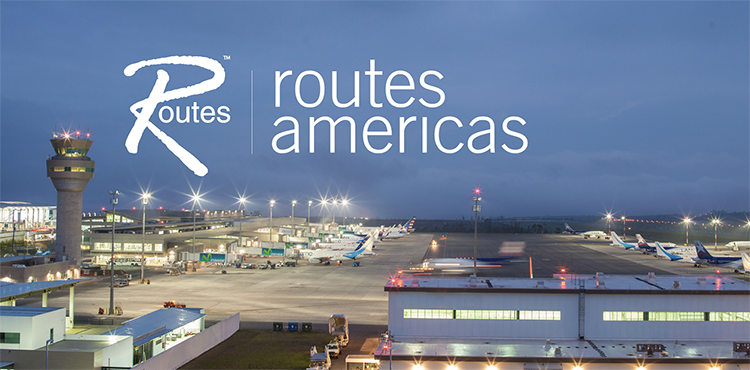
Corporación Quiport, the concessionaire responsible for the general management of the airport, constantly promotes joint work strategies with domestic and international airlines to increase connectivity. This makes Quito International Airport an attractive and safe place for operations, with high levels of service.
Corporación Quiport works non-stop to develop connectivity. This year at the Routes Americas 2020 held in Indianapolis, USA, Quiport’s Route Development team met with 22 airlines and airports to discuss and seek partnerships to bring new airlines to the Ecuadorian market and increase destinations and frequencies.
Mariscal Sucre International Airport is the main gateway that connects the city and Ecuador to the world. For several years, Corporación Quiport has implemented a route development strategy to attract more airlines to the country, under the premise that airlines are not just customers and users of the airport but are strategic partners for the growth of connectivity.
Quiport works with these companies on a continuous basis through direct conversations to attract new airlines to Quito and develop new routes or increase capacity and frequencies on existing routes. It is also responsible for creating a positive ecosystem so that airlines can operate successfully at the airport.
Andrew O’Brian, President and CEO of Corporación Quiport, explains that participating in Routes Americas has special importance as it is the basis for the entire strategy to increase connectivity at Mariscal Sucre Airport. “Participating in Routes Americas allows us to follow up on conversations and negotiations with various airlines, but it is also an ideal opportunity to propose new direct flights and present airlines with studies and figures on their potential. During our meetings with the airports, we establish joint strategies and incentive packages for the airlines we want to open routes with”. He adds that 2019 was a year of record growth in connectivity at Quito Airport since it opened in 2013.
Quiport understands that the development of a new route and increases in frequencies and capacity require the airline to invest significant resources and to take on risks. With a flexible policy, the concessionaire seeks to share part of the risk of route development. This is why it works together with the Municipality of Quito and the central government, in conjunction with airlines, to develop incentive plans tailored to the needs of each airline.
Thanks to the work strategies with the airlines, today Quito International Airport is highly valued for creating a collaborative ecosystem which facilitates the development of airline operations. This is designed to serve both new companies starting up operations and those already operating in the city.
QUITO AIRPORT’S RESPONSE TO THE INTERNATIONAL EMERGENCY OVER THE NEW CORONAVIRUS
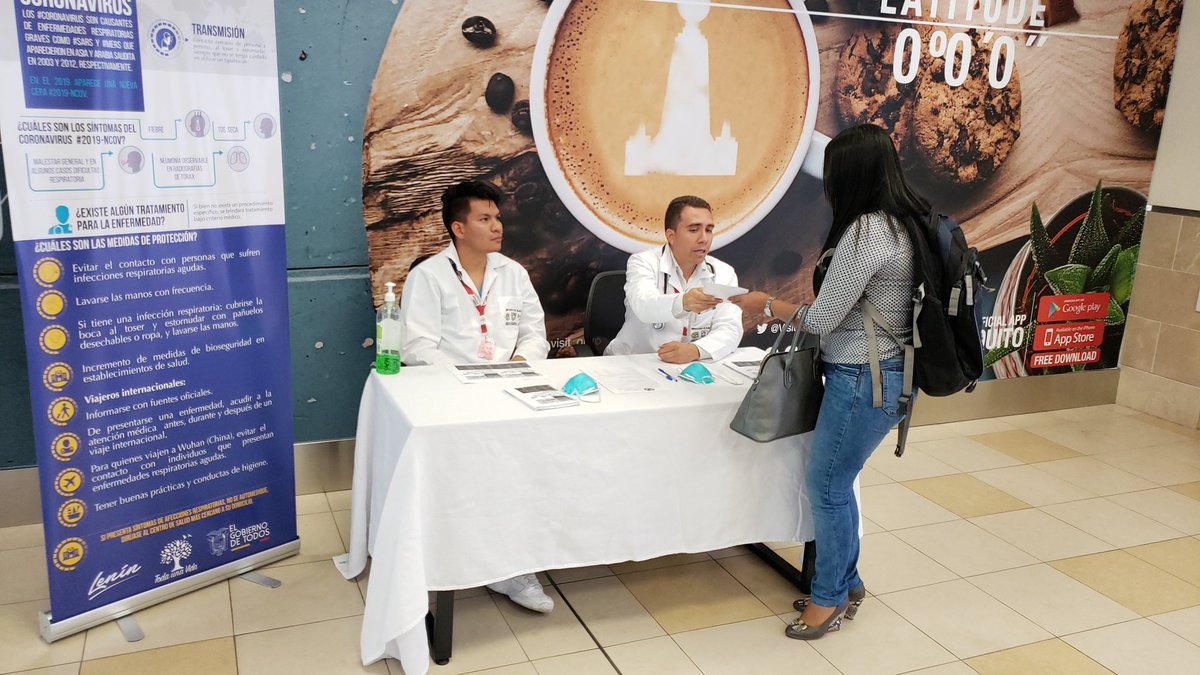
Yesterday, January 30, the World Health Organization (WHO) declared the outbreak of novel coronavirus (2019-nCoV) in China a public health emergency of international concern.
Corporación Quiport, concessionaire of the Quito airport service, is continuously providing every facility to apply the information and control protocols set in place by the Ministry of Public Health in Ecuador (MPH), following WHO guidelines. Currently, the Ministry has six information and prevention points plus 18 health professionals and is providing information in various areas and on screens at the passenger terminal of Quito International Airport. The Municipality of Quito has set up two additional information points in the terminal as well.
The epidemiological surveillance protocol in Ecuador – enforced by the Health Ministry in compliance with international health measures – includes active surveillance, early detection, isolation, case management, contact tracing and prevention of infection by 2019-nCoV.
As an additional measure, in coordination with the Municipality of Quito through Empresa Pública Metropolitana de Servicios Aeroportuarios, Quiport is implementing a plan to disinfect areas frequented by passengers in the terminal. This includes international arrivals (boarding bridges, stairs, handrails, elevators, bathrooms, baggage carousels, immigration counters, customs), international departures (security screening, transit, immigration counters). Virkom, a hospital-use broad spectrum virucidal disinfectant is used.
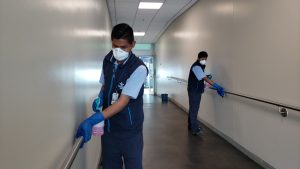
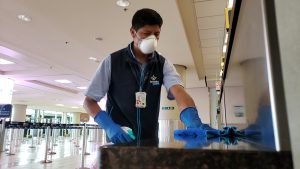

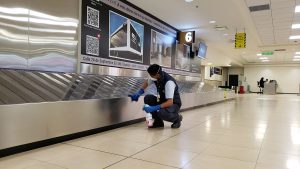
Sandro Ruiz, General Manager of Empresa Pública Metropolitana de Servicios Aeroportuarios says “we are ready to respond to citizens’ calls for information and are working together with the Ministry of Health and Quiport. Mariscal Sucre Airport has taken the good initiative to safeguard the wellbeing of passengers with this continuous disinfection, an action which is in addition to keeping citizens informed in this regard.”
Andrew O’Brian, President and CEO of Quiport, explains that the airport is providing all its support to the country and city to implement prevention measures in the face of this outbreak. “It is important that passengers who arrive at our airport receive all the necessary information about the disease and see the presence of the State in prevention activities. On our part, the operation to disinfect the terminal is an additional measure to safeguard the health of passengers and airport employees”.
In coordination with all operators, employees who work at Quito International Airport observe health and hygiene measures such as constantly washing hands and using disinfectant gel to prevent respiratory infections, and seeking immediate medical attention if symptoms occur.
The authorities have called on citizens to remain calm and only obtain information from official sources. There is constant communication between the airport community, led by Corporación Quiport, and the civil aviation and public health authorities.
2019, A RECORD YEAR FOR CONNECTIVITY AND ENHANCED SERVICES AT QUITO MARISCAL SUCRE AIRPORT
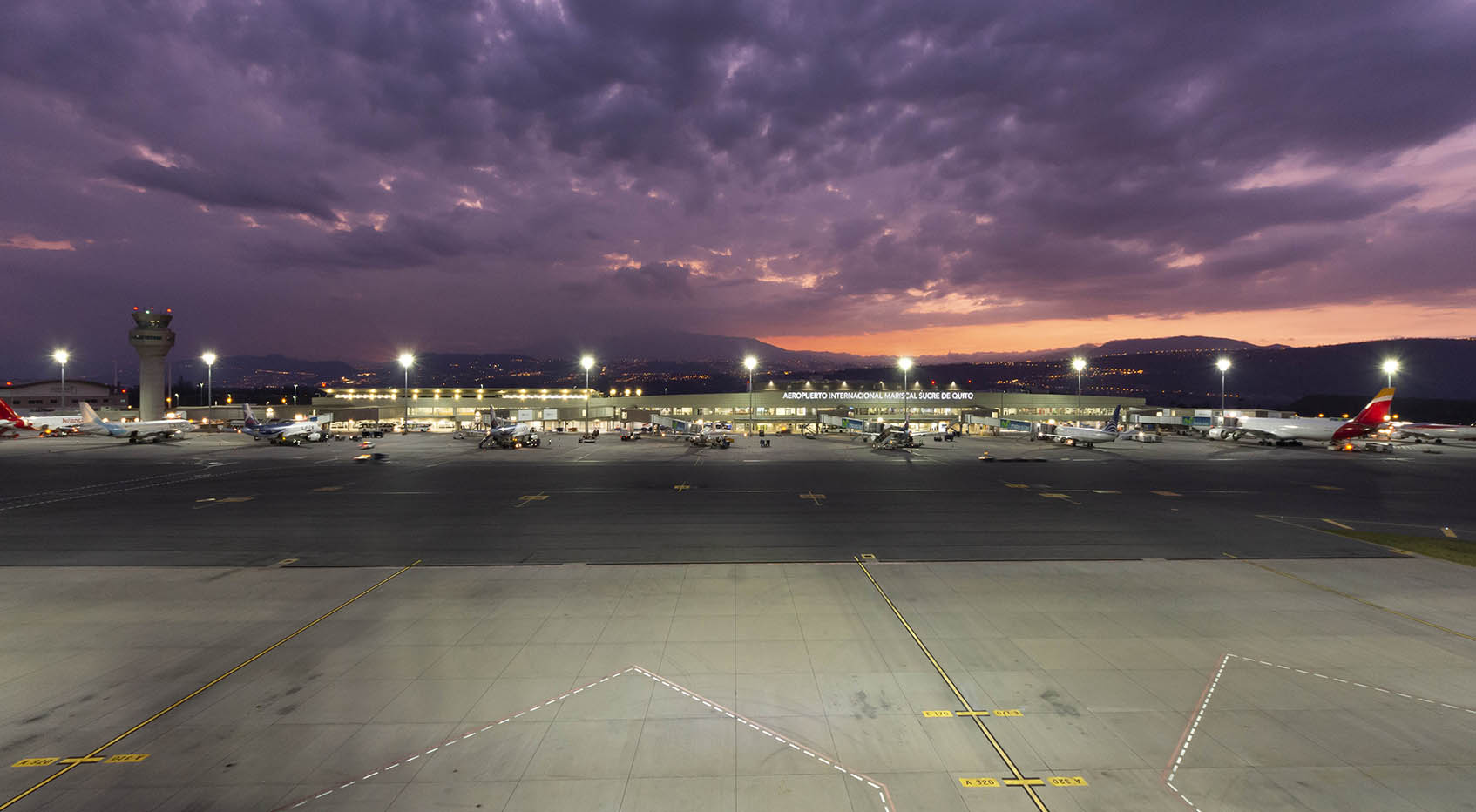
- Increased connectivity with the world, launch of new routes and new domestic and international airlines.
- Expansion of the passenger terminal building with a US$ 60 million investment.
- Continued enhancement of user services and execution of social and environmental responsibility projec
Corporación Quiport’s performance in 2019 has had positive results across all areas of work by the company in charge of Quito International Airport. Below we set out our biggest achievements in 2019.
Connectivity
In 2019 four new international airlines were added to Quito Airport’s list of carriers: Air France, Plus Ultra, Air Canada and Interjet, as well as one domestic airline: Aeroregional. We also expanded international routes with the addition of Toronto, Dallas, Paris and Santiago, and domestically we increased flights to Guayaquil, Cuenca, Manta, Coca and Santa Rosa. Quiport works together with the national government and the Municipality of Quito on a route development strategy to promote connectivity in Quito, presenting it as an attractive destination for tourism and business. There is increasing interest from airlines in Quito and Ecuador thanks to tourism campaigns and an open skies policy which demonstrate the country’s willingness to welcome new airlines.
Cargo
In 2019, for the second consecutive year, cargo operations at Quito International Airport were awarded in the Air Cargo Excellence Awards (ACE) the Diamond Award (first place) in the category of airports up to 399,999 tons of cargo per year, Top Cargo Airport in Latin America and top airport for Specialty Cargo worldwide. This is topped off by a new record for cargo for the Valentine’s Day season, with more than 18,000 tons exported.
Infrastructure
Works began on the redesign of the public departures hall and expansion of the passenger terminal building, the results of which will no doubt provide a positive experience to users.
The works in the public hall, which began in July, aim to enhance the comfort of passengers by optimizing spaces and the flow in the airport. The space will be given a new design to celebrate the context of the airport and the city: a warm natural land full of life with a unique culture and friendly people. An investment of US$ 21 million has been made in the redesign of the departures and arrivals hall, which will be delivered in 2020.
On November 18, 2019, works began to expand the passenger terminal building. With an investment of US$ 60 million,this building will have an area of 16,000 m2. Once the works are completed the terminal will see a 35% increase in areas such as the departure lounges, public departures and arrivals hall, immigration area, customs, and baggage reclaim area.
The space will have a highly functional design and decor to highlight the airport’s identification with the city and its surroundings. This will be achieved with materials and colors such as blue tones in the carpets to recreate the skies of Quito, wood, granite and green spaces.
Passenger Service
To provide a positive experience to users and passengers, new water bottle refill and drinking fountains in the departure lounges and the departures and arrivals hall. This aims to reduce the use of plastic bottles. The water fountains provide 100% purified water. Additionally, we have renovated and increased the number of self-service check-in kiosks which also allow passengers to print labels for checked baggage.
The Domestic VIP Lounge was refurbished with modern decor and designed to enhance the comfort of passengers and increase capacity. The International VIP Lounge was the Global Winner of the Priority Pass Lounge of the Year Awards.
Passengers who travel with pets have the convenience of pet relief areas equipped with hydro-sanitary systems, artificial turf, disposable bags and trash cans. These areas are found in the domestic and international departure lounges and the sidewalk by domestic arrivals.
Social and Environmental Responsibility
It is essential to carry out the airport’s activities within a sustainable, environmentally friendly framework which is responsible towards the community. For this reason, 11 social responsibility programs are carried out for the benefit of more than 45,000 people.
In 2015, the airport joined the Airport Carbon Accreditation (ACA) Program and in 2019 it completed the four stages of the program with concrete actions to reduce greenhouse gas emissions, save fuel, increase energy efficiency and appropriate water use, and protect conservation areas for flora and fauna. The result: Mariscal Sucre Airport became the first international airport in Latin America to obtain carbon neutral status. Also, in 2019 the airport subscribed to the United Nations Global Compact.
Awards
Quiport’s work at Quito International Airport has been recognized by an array of industry stakeholders. In March, Skytrax awarded the airport the Best Regional Airport in South America for the fourth time and Best Airport Staff in South America for the third time as well as renewing its Four-Star Airport status. For the sixth consecutive year, the airport was named South America’s Leading Airport at the World Travel Awards and was ranked 12th in the best airport rankings worldwide by AirHelp, an international organization which advocates for air passenger rights around the world.
The airport’s cargo terminal was awarded the top Diamond status in the category of 399,999 tonnes of cargo per year, as well as the Top Airport in Latin America and Top Airport – Speciality Cargo by Air Cargo Excellence.
In short, 2019 was a highly positive year for airport development in Quito. The results reflect the joint work with the national government, Municipality of Quito and the airport community to increase efforts and find opportunities for improvement to contribute to the progress of the city and country.
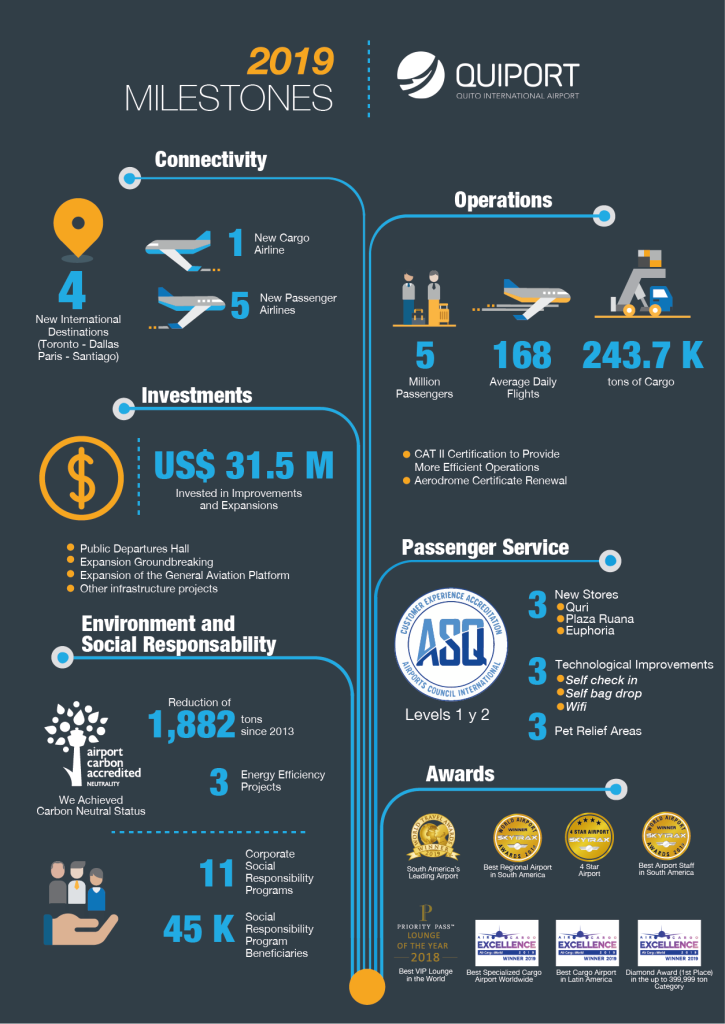
MARISCAL SUCRE AIRPORT ENDS A GREAT YEAR FOR CONNECTIVITY WITH THE INAUGURAL FLIGHT ON THE DALLAS FORT WORTH – QUITO ROUTE
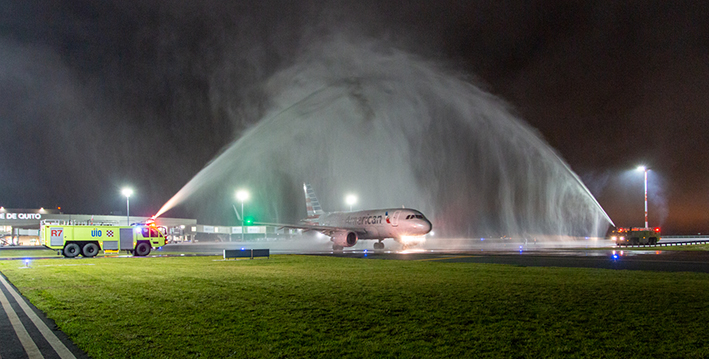
- Starting from December 18, American Airlines will offer a new route served by an Airbus 319.
American Airlines will fly from Mariscal Sucre Airport to Dallas Fort Worth (DFW) with seven weekly frequencies served by Airbus 319 aircraft. This increases the range of destinations to Europe and Asia, in addition to the 900 domestic destinations served by connections within the United States.
“With this new route between Quito and Dallas, we have increased our capacity by 50%, strengthening our nearly 30-year commitment with the country”, says Edwin Rincon, Commercial Manager at American Airlines in Ecuador. “From DFW we offer countless connections, guaranteeing a greater flow of tourists to Ecuador and also connecting the country and our Ecuadorian customers to a vast number of destinations in Asia, Europe and around the USA”.
“Tonight, we as Ecuadorians are particularly pleased that American Airlines is expanding its services with daily direct flights from Dallas to Quito and Guayaquil. This confirms its confidence in Ecuador and facilitates the arrival of more tourists from our priority market, the USA, and from the rest of the world” confirms Rosi Prado de Holguín, Minister of Tourism.
For Quiport, concessionaire of the airport service, expanding destinations which will represent further growth, help to develop air connectivity and encourage tourism is one of its main objectives as part of its strategic goals. Andrew O’Brian, President and CEO of Corporación Quiport, says “our joint work with the Ministry of Tourism and the Municipality of Quito has been very intense, and as a result we have achieved a record year for connectivity. Today, Quito and Ecuador are more connected than ever to the world”.
“It has been a successful year for the airport’s connectivity processes. It is good news for the city, and the Municipality of Quito through Empresa Pública Metropolitana de Servicios Aeroportuarios welcomes this flight with open arms” says Sandro Ruiz, General Manager of Empresa Pública Metropolitana de Servicios Aeroportuarios.
THE LARGEST CANADIAN AIRLINE HAS LAUNCHED NONSTOP SERVICE BETWEEN TORONTO AND QUITO
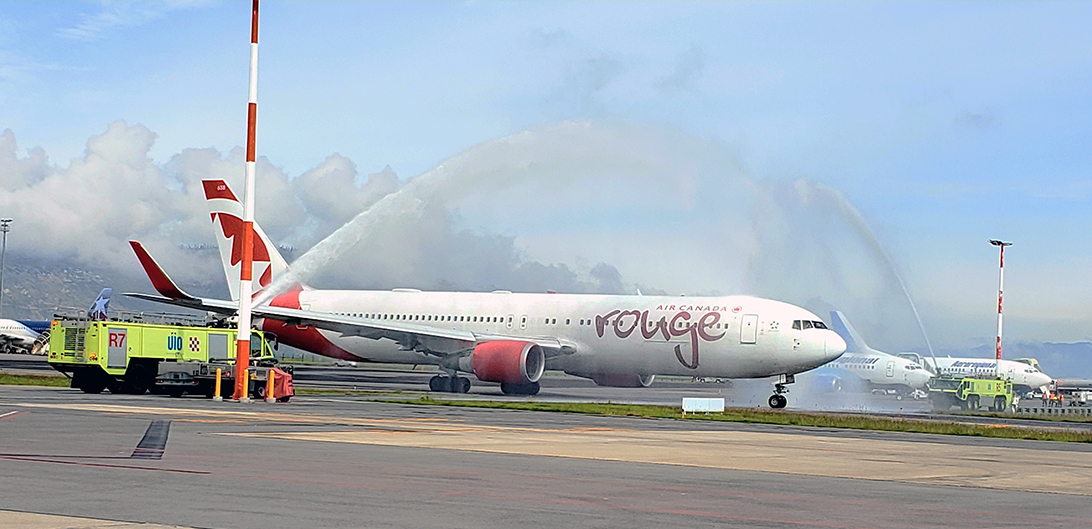
- This Monday, December 9, Air Canada Rouge commenced nonstop operations between Toronto and Quito with a Boeing 767-300 aircraft.
Departing from Quito International Airport, Air Canada Rouge launched three weekly nonstop flights with a Boeing 767-300 wide cabin aircraft from Toronto Pearson International Airport. The arrival of the Canadian airline is the result of joint efforts of Corporación Quiport, the Ecuadorian Government and the Municipality of Quito, which have committed themselves to increasing connectivity in the country.
The duration of the new nonstop flight is six hours and 35 minutes, directly connecting travelers from both countries; and throughout Air Canada’s international destinations from their Toronto based hub.
A strengthened relationship between Ecuador and Canada responds to the interest of Ecuadorians in Canada as a destination for tourism, education and business and will support the growing interest among Canadian tourists about Quito. It will also bring the Ecuadorian community residing in Canada closer to their home country.
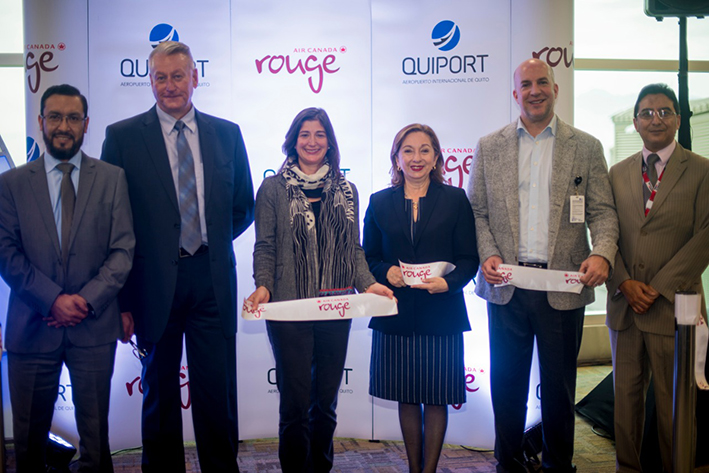
“We are delighted with this new route that will connect another South American capital with our hub in Toronto. We have worked hard and are very proud to be the first Canadian airline to cover the Quito-Toronto route, thus bringing both countries closer together, strengthening trade and tourism, and increasing opportunities for hundreds of students,” said Alfredo Babún, Air Canada Regional Manager for Andean Countries.
Ecuadorian Tourism Minister, Rosi Prado de Holguín welcomed Air Canada Rouge, “which arrives in Ecuador to shorten the distance between these two countries and facilitate the arrival of Canadian tourists who are eager to enjoy the warmth and beauty of our ‘four worlds’.”
“Quito Airport is ready to welcome all Canadian and international tourists,” said Andrew O’Brian, President and Director General of Corporación Quiport, operator of the Quito International Airport, who also explained that Canada is not only a new destination, but also a new market with much potential. He also noted that Quito is a tourist destination with great potential for Canadian travelers who are eager to visit different places and see different customs. In this sense, Ecuador has much to offer in cultural and historical tourism, adventure and nature, besides its amazing beaches.
According to Sandro Ruiz, General Manager of Empresa Pública Metropolitana de Servicios Aeroportuarios (EPMSA), “this great step towards connectivity confirms that progress has been made in tourism in the country and the city as a result of joint hard work. And the Municipality of Quito is honored to welcome this airline as part of the city’s productive development process”.
Finally, Sylvie Bédard, Canadian Ambassador to Ecuador, said that “it was great to board the plane yesterday night in Toronto and arrive in Quito today in the early morning! This new route is, without a doubt, a milestone that will bring our countries and our people together in trade, tourism, education and investment. Air Canada Rouge has shortened the distance and is offering an excellent option for businesspeople, students, tourists and products to reach both countries. I wish to congratulate Air Canada, the Quito airport and Quiport, the Ministry of Transport and the Ministry of Tourism, and the Ecuadorian Embassy for the great joint efforts that have turned this project into a reality.”

QUITO AIRPORT IS THE FIRST IN ECUADOR TO BE CERTIFIED FOR ILS CATEGORY II OPERATIONS IN LOW VISIBILITY

This system helps to reduce cancellations, delays or diversions due to fog, increasing capacity at the airport to high international safety standards.
Since 2013, the Civil Aviation Authority (DGAC) has worked with Corporación Quiport to implement air navigation aids. To this end, equipment and systems have been installed such as the ILS (Instrumental Landing System), RVR (Runway Visual Range) and runway centerline lighting, all to increase the operational availability of the capital’s airport in foggy or low visibility conditions. These measures have led to Quito Airport becoming the first in Ecuador to be certified in ILS Category II.
The ILS is an approach and landing aid, which is used globally to guide aircraft with precision during their approach to the runway and, in some cases, along it. This system has 3 categories of operation and is established by the International Civil Aviation Organization (ICAO).
At Quito Airport, runway 36 currently has Category II precision approach and runway 18 has Category I precision approach. Because of this, the Civil Aviation Authority has certified the approach procedures and the Quito International Airport Aerodrome Manual and has authorized operations in adverse weather conditions (severe fog).
The Civil Aviation Authority states that Category II approaches allow aircraft to land at a decision altitude of 100 feet (30.48 meters) and visibility of just 1,200 feet (350 meters). This benefits passengers and airlines by preventing delays, diversions or cancellations due to fog. “CAT II guarantees that Mariscal Sucre Airport has a first-rate infrastructure, placing it at the forefront of international airports” says Anyelo Acosta, Director General of Civil Aviation.
Andrew O´Brian, President and CEO of Corporación Quiport, indicates “to be pleased to have ILS CAT II at Mariscal Sucre Airport, the first airport in the country and one of the first in Latin America to achieve this. This means 99% effectiveness and a high level of safety at the airport, a goal we have had since 2013 ”. He adds that in order to comply with all the technical requirements of this certification, intense work has been carried out with the technicians of Quiport and DGAC; contributing to the development of air transport in Ecuador and making the airport a platform for quality at a national and international level.

Lastly, Pablo Galindo, Undersecretary of Air Transport at the Ministry of Transport and Public Works, says that the certification is a clear and strong signal that will attract other airlines to Ecuador. He emphasizes that the certification is the result of joint work by the private company and the public sector who have become strategic partners for tourism investment and connectivity in Ecuador.
QUIPORT BEGINS THE PASSENGER TERMINAL EXPANSION AT MARISCAL SUCRE AIRPORT
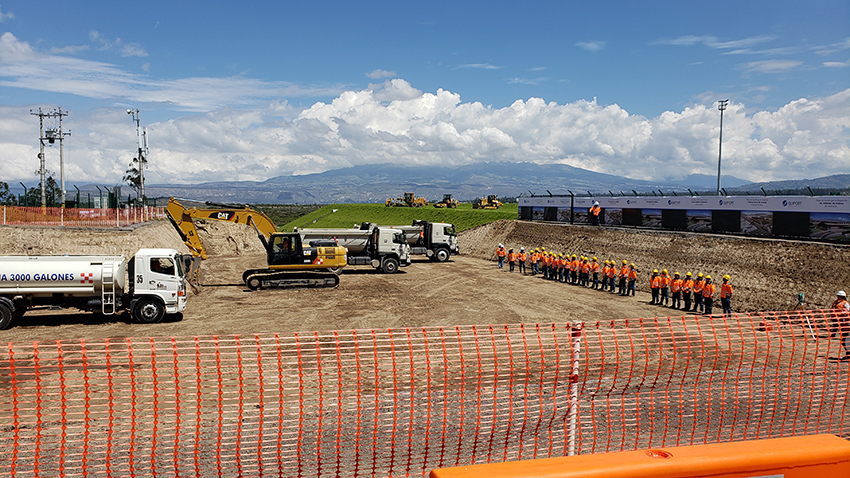
From 2019 to 2020, Corporación Quiport, concessionaire of the airport service, will execute the project to expand the passenger terminal and apron, with an investment of US$ 60 million.
In 2020 the terminal will increase by 35%, with an additional 6 self-service check-in kiosks and a 32% increase in the check-in area to improve the travel experience for passengers. The expansion of the boarding area will increase capacity by 19% in the boarding lounges, thanks to an additional 3,200 m2. The passenger apron will increase by 24,214 m2 with 2 extra parking positions for aircraft.
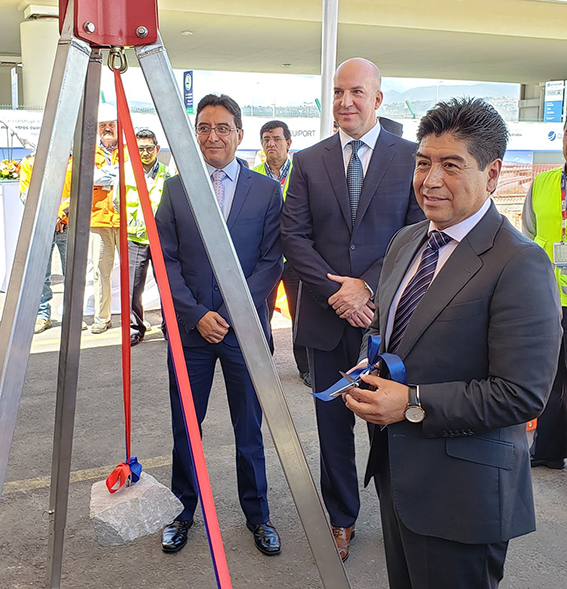
The work which began yesterday is part of the master plan for airport development approved by the Municipality of Quito, which counts on collaboration and joint work with the Civil Aviation Authority and the Ministry of Transport and Public Works.
For Andrew O’Brian, President and CEO of Corporación Quiport “all the actions carried out by the concessionaire are focused on the economic, social and tourism development of Quito and the country”. He adds that the 13-month construction process will create around 2,700 direct, indirect and induced jobs. He explains that Quiport aims to provide a unique experience to its passengers and a sense of belonging for Ecuadorians.
In the passenger area, the design, materials and colors aim to create a greater sense of belonging with the city. The areas for check-in, immigration and screening at departures and arrivals, baggage claim hall and customs will be expanded to offer greater comfort and efficiency.
The new space in the departures area will have services including free Wi-Fi, many power outlets, leading retail stores, restaurants with new national and international gastronomic options and a more practical play area for children.
“All of this will help to achieve the Wow! factor we want for our passengers and users”, says Andrew O’Brian.
Sandro Ruiz, General Manager of Empresa Pública Metropolitana de Servicios Aeroportuarios, congratulated the teamwork being performed for the benefit of Quito, its development and growth. “We are convinced that we must continue to focus on connectivity, tourism and productive development, and these types of projects and initiatives are key to delivering a legacy of quality for future generations”.
Jorge Yunda, Mayor of Quito, remarks on the positive influence that Mariscal Sucre Airport has had on various productive activities in the city, and he emphasizes the need to continue to focus combined efforts on connectivity and to support the actions of the airport. “This is why I am interested in supporting Quiport and encouraging our airport to keep growing and creating more services for the people”.
The works will involve prestigious local contractors such as Adriana Hoyos Design Studio, Tracto repuestos, Irigoyen, Ecuatest, Prestop, and international contractors including Stantec, Jetway and Smiths Detection.
The expansion project will be executed with the highest standards of service and quality, a reflection of the airport service which will continue to provide a unique experience to passengers. This way, Corporación Quiport reaffirms its commitment to offer infrastructure that will meet the country’s requirements for growth.
THE LOW-COST MEXICAN AIRLINE WILL OPERATE 7 WEEKLY FLIGHTS AND SHOWS THE GREAT POTENTIAL FOR GROWTH OF THIS ROUTE BETWEEN THE CAPITAL CITIES OF ECUADOR AND MEXICO.
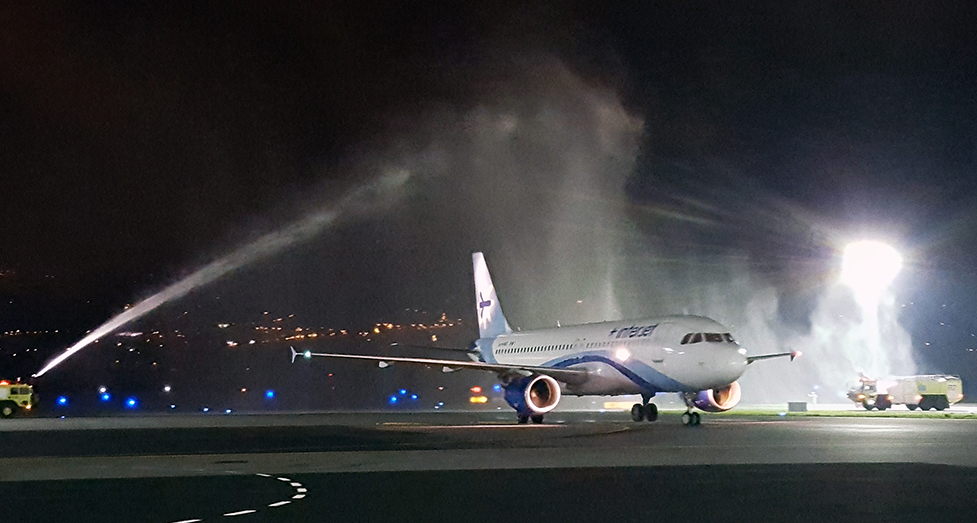
- The low-cost Mexican airline will operate 7 weekly flights and shows the great potential for growth of this route between the capital cities of Ecuador and Mexico.
Connectivity between Quito and Mexico City has significantly increased with the arrival of Interjet, the low-cost Mexican airline that began operations this Tuesday, October 29. Interjet offers seven direct weekly flights from Quito International Airport, served by an Airbus 320.
For Corporación Quiport, the concessionaire of the airport, the addition of Interjet is a very positive development for this route, as the new operator will invigorate the market and help regulate air ticket prices.
“There is no doubt that the Mexican government’s decision to eliminate the visa requirement for Ecuadorian citizens gave us a strong push to bring Interjet to Quito”, says Andrew O’Brian, President and CEO of Corporación Quiport. “The exchange of passengers between the two destinations is key to the route’s success, and the work to promote tourism that Ecuador can carry out in Mexico is very important” he adds.
For Julio Gamero, Executive Commercial Director of Interjet, “as we begin this new chapter, this direct route between Mexico City and Quito is a sign of the significant growth we are seeing in the region. Interjet brings an innovative price offering, while maintaining the service’s high standards of quality and safety. We are very pleased to have a partner like Quiport, who has supported us to make our arrival in Quito a reality”.
For Sandro Ruiz, General Manager of Empresa Pública Metropolitana de Servicios Aeroportuarios (EPMSA), “air connectivity continues to improve. With the addition of Interjet, Quiport continues to increase the number of airlines at Mariscal Sucre International Airport, a sign of confidence in the country which encourages tourism and business”.
EXPERIENCE THE INNOVATIVE DREAMLINER EFFECT FROM QUITO AIRPORT
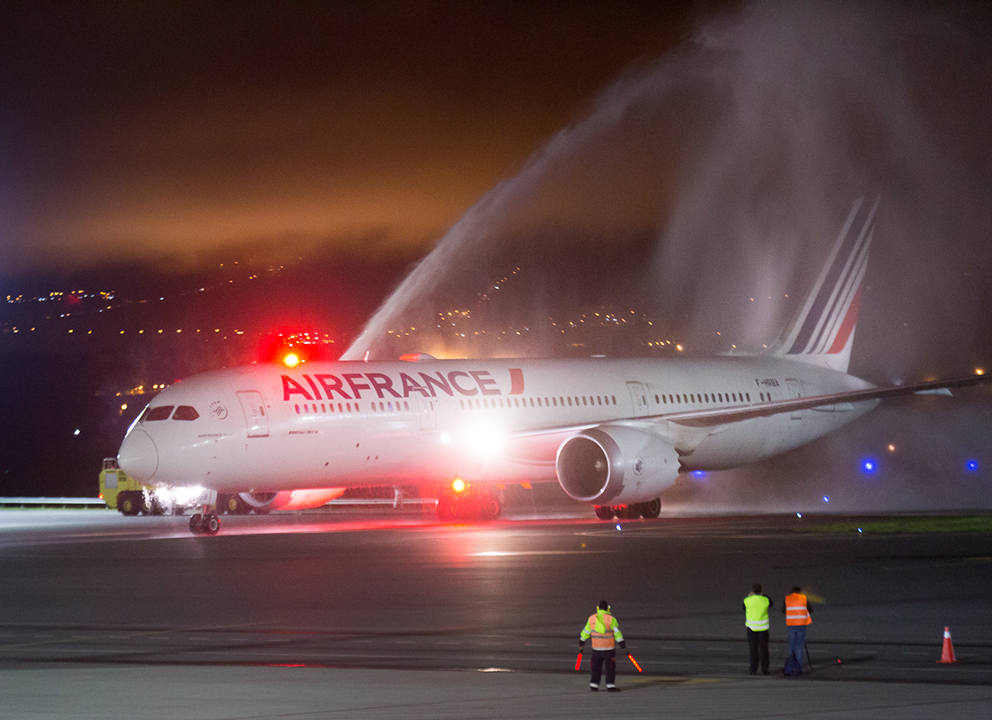
From October 27 at Quito Airport, passengers can enjoy an innovative experience onboard the Dreamliner 787-900, operated by Air France. The modern aircraft arrived in Quito for the first time yesterday from Paris Charles de Gaulle Airport.
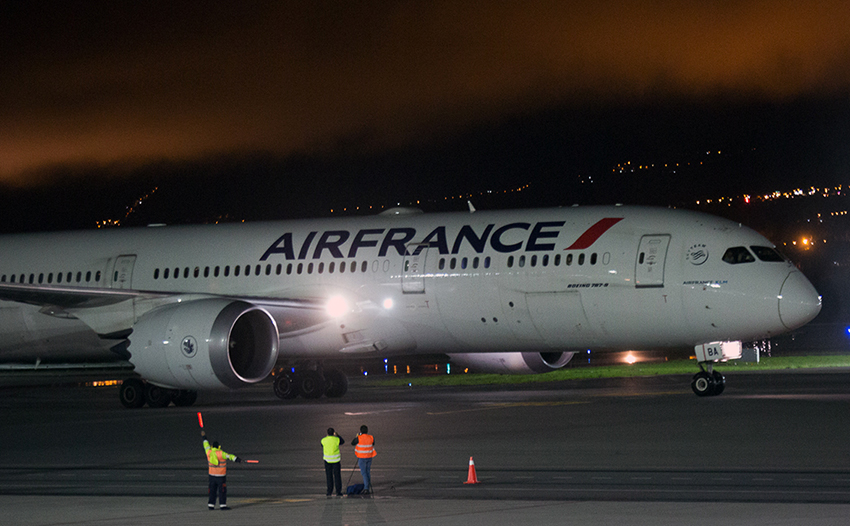
This new service with the Boeing 787-900 is very important for Corporación Quiport. It is a new generation aircraft that provides more comfort and is very efficient, offering Ecuadorian passengers a new flying experience. Air France’s decision shows the importance it places on developing its market in Ecuador, says Andrew O´Brian, CEO of Quiport.
The Boeing 787, with capacity for 276 passengers, is the most modern aircraft in Air France’s fleet, offering multiple benefits to its passengers to make long journeys more enjoyable. It is equipped with three cabin classes: business with 30 seats; premium economy with 21 seats, and economy with 225 seats.
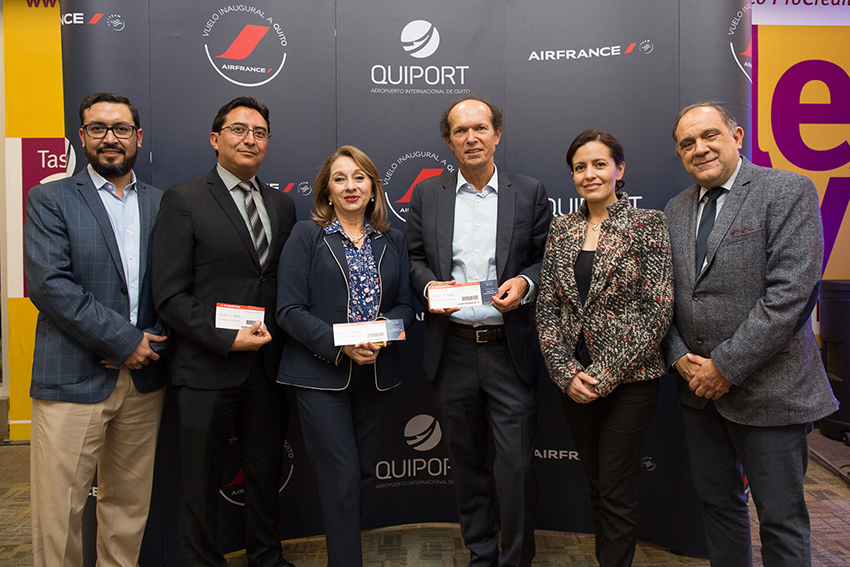
Air France operates three direct flights between Quito and Paris Charles de Gaulle Airport on Tuesdays, Fridays and Sundays.
Elisa Dhuvettere, Regional Commercial Director of Air France, emphasizes that the airline has full faith in the tourism potential of Ecuador, which is why the airline has decided to bring in the new generation aircraft to serve the country.
From Quito Airport, passengers will have a more comfortable experience with enhanced seats and 30% larger windows compared to other similar aircraft. The Dreamliner also offers a lower cabin altitude and better humidity, ensuring a more comfortable and pleasant journey.
Sandro Ruiz, General Manager of Empresa Pública Metropolitana de Servicios Aeroportuarios, says “we are very pleased with Quiport’s work to increase connectivity, as shown by Air France’s decision to send one of the most modern aircraft to serve our skies”.
The evening reception to welcome the Dreamliner ended with words from Rosi Prado de Holguín, Minister of Tourism, who stated the importance of emphasizing that Ecuador is a peaceful country, and the arrival of the Dreamliner is a show of trust and reflects the potential for tourism we have and need.

